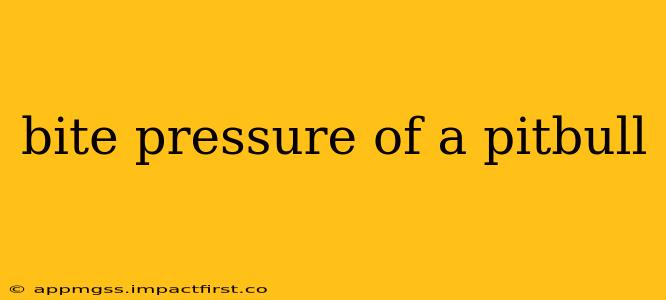The bite pressure of a Pit Bull, or more accurately, any dog breed, is a complex issue often clouded by misinformation and sensationalism. While anecdotal evidence and media portrayals frequently depict Pit Bulls as possessing exceptionally strong bites, the truth is far more nuanced. There's no single definitive answer to the question of "how strong is a Pit Bull's bite?" Several factors contribute to the force of a dog's bite, and breed alone is not the sole determinant.
What Determines a Dog's Bite Force?
Several factors influence the force of a dog's bite, including:
- Breed: While certain breeds might have a genetic predisposition towards stronger jaw muscles, this isn't the only factor. Variations within breeds exist.
- Size and Weight: Larger and heavier dogs generally exert more bite force simply due to their physical size and muscle mass.
- Jaw Structure: The shape and structure of a dog's jaw influence its biting power.
- Training and Socialization: A well-trained and properly socialized dog, regardless of breed, is less likely to bite with excessive force. Conversely, a dog that hasn't received proper training or has experienced trauma may bite more forcefully due to fear, aggression, or pain.
- Individual Variation: Just like humans, dogs have individual variations in strength and temperament. Two Pit Bulls might have significantly different bite pressures.
How Strong is a Pit Bull's Bite Compared to Other Breeds?
Several studies have attempted to measure canine bite force, but results vary significantly due to methodologies and sample sizes. While some studies suggest that certain breeds like Rottweilers and German Shepherds may have higher recorded bite forces in controlled settings, these studies often fail to account for the significant impact of training and individual variation. The raw bite force number, even if accurate for a specific individual dog, doesn't fully represent the potential damage caused by a bite. Factors like the duration of the bite, the area targeted, and the dog's temperament are equally critical.
Are Pit Bulls More Dangerous Than Other Breeds?
The narrative surrounding Pit Bulls often focuses on their bite strength, implying inherent danger. However, breed-specific legislation and restrictions are often based on flawed assumptions. Statistics on dog bites show that a variety of breeds are involved in incidents, and bite severity is more strongly linked to factors like owner responsibility, training, and socialization rather than breed alone. A poorly trained or neglected dog of any breed poses a significant risk. Focusing solely on breed overlooks the critical role of responsible dog ownership in preventing bites.
How Can I Minimize the Risk of a Dog Bite?
Regardless of breed, responsible dog ownership is paramount in minimizing the risk of dog bites. This includes:
- Proper Training and Socialization: Early socialization and consistent training are essential for a well-behaved dog.
- Responsible Ownership: Understanding canine behavior and responding appropriately to signs of aggression or stress is crucial.
- Supervision: Always supervise interactions between dogs and people, particularly children.
- Avoid Triggering Behaviors: Understanding what might trigger aggression in a dog and avoiding those situations is preventative.
What are the legal implications surrounding Pit Bulls?
Many jurisdictions have breed-specific legislation targeting Pit Bulls and similar breeds. These laws vary significantly and are often controversial, with many arguing that focusing on breed is ineffective and ignores the crucial role of responsible ownership. The legal implications of owning a Pit Bull depend heavily on local laws and regulations.
In conclusion, while some breeds may possess a genetically predisposed tendency towards stronger jaw muscles, responsible ownership, proper training, and socialization play the most significant roles in preventing bites and ensuring the safety of both humans and dogs. Focusing on breed-specific bite force without considering other crucial elements paints an incomplete and misleading picture.
